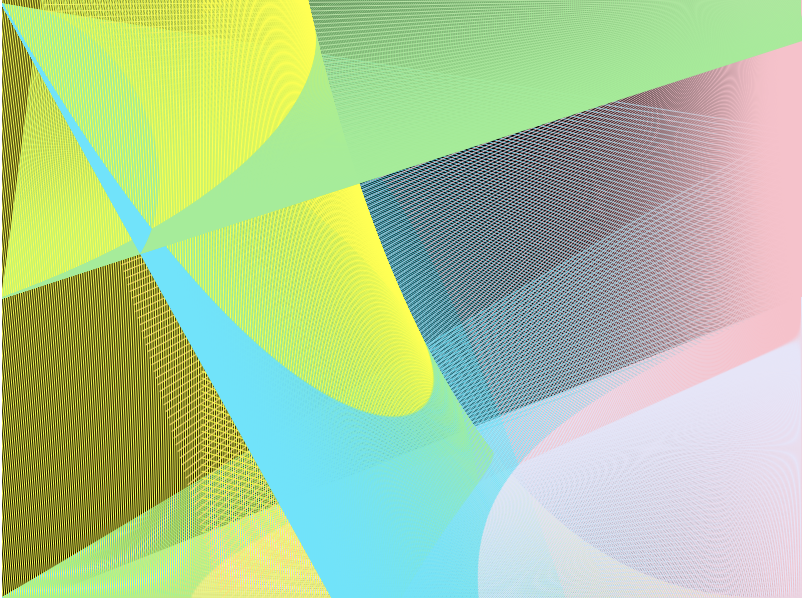/* eliana fleischer
efleisch
section e */
//GLOBAL VARIABLES
// these global variables will be used to be able to change the values while drawing different string arts
var dx1;
var dx2;
var dy1;
var dy2;
var dx3;
var dy3;
var dx4;
var dy4;
var numLines1 = 50;
var numLines2 = 15;
var ax1 = 50;
var ax2 = 150;
var ay1 = 50;
var ay2 = 300;
var bx1 = 300;
var bx2 = 350;
var by1 = 300;
var by2 = 100;
function setup() {
createCanvas(400, 300);
background(124,158,129);
}
function draw() {
push(); // push will create the bold deges of the lines
stroke(0);
strokeWeight(4);
ax1 = floor(random(15,200)); // randomize x values for the two lines
ax2 = floor(random(15,200));
bx1 = floor(random(200,385));
bx2 = floor(random(200,385));
ay1 = floor(random(15,150)); // randomize the y values for the two anchor lines
ay2 = floor(random(150,285));
by1 = floor(random(150,285));
by2 = floor(random(15,150));
line(ax1, ay1, ax2, ay2); // anchor line A
line(bx1, by1, bx2, by2); // anchor line B
dx1 = (ax2-ax1)/numLines2; // creates dx and dy for the lines created divided by numLines
dx2 = (bx2-bx1)/numLines2;
dy1 = (ay2-ay1)/numLines2;
dy2 = (by2-by1)/numLines2;
var x1 = ax1; // set the starting points of the string art lines to the anchor line values
var y1 = ay1;
var x2 = bx1;
var y2 = by1;
line(15,15, 385, 15); // upper anchor line
line(15,285,385,285); // lower anchor line
var x3 = 15; // creates the initial changing x values
var x4 = 385;
var x5 = 15;
var x6 = 385;
dx3 = (385-15)/numLines1; // dx for the lines going to the left
dx4 = (15 - 385)/numLines1; // dx for the lines going to the right
pop();
for (var i = 0; i <= numLines1; i +=1){ // for loop making the background lines
stroke(243,204,113); // orange lines
line(15,15, x3, 285); // lines going to left
stroke(247,255,118); // yellow lines
line(385,15,x4,285); // lines going to the right
stroke(236,180,236); //purple lines
line(15,285,x5,15); //lines from the bottom going left
stroke(236,180,180); // pink lines
line(385,285,x6,15); // lines from the bottom going right
x3 += dx3; // changes the x values by the set dx
x4 += dx4;
x5 += dx3;
x6 += dx4
}
stroke(29,5,95);
strokeWeight(3)
for (var i = 0; i <= numLines2; i+=1){
line(x1, y1, x2, y2); // uses the randomly generated points to start lines
x1 += dx1; // chnages the values by the set dxs and dys
y1 += dy1;
x2 += dx2;
y2 += dy2;
}
noLoop();
}
I think the most difficult part of this project for me was creating an interesting image. I did this by randomizing one of the string art shapes.
![[OLD SEMESTER] 15-104 • Introduction to Computing for Creative Practice](../../../../wp-content/uploads/2023/09/stop-banner.png)
